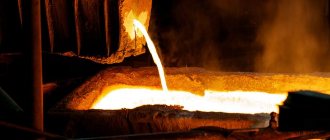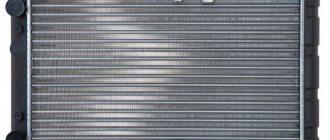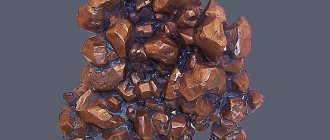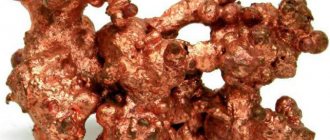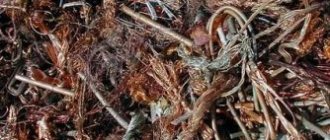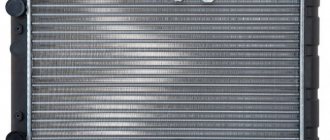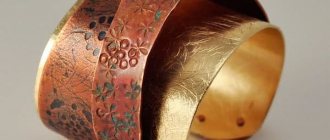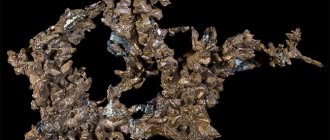Synonyms: Thin mixtures of native copper and cuprite were called cuprocuprite (Vernadsky, 1910). Whitneyite—whitneyite (Ghent, 1859) and darwinite (Forbes, 1860)—arsenic copper that forms mixtures with algodonite.
Group
origin of name
The Latin name for copper, cuprum, comes from the name of the island of Cyprus, from where copper was imported in ancient times. The origin of the Russian name is unclear.
The English name for the mineral Copper is Copper.
Copper nugget
Chemical composition
Sometimes it contains impurities of Fe, Ag, Pb, Au, Hg, Bi, Sb, V, Ge3 (silver copper with 3-4% Ag, ferruginous copper - 2.5% Fe and golden copper - 2-3% Au). Impurities are observed more often in primary native copper; Recycled copper is usually purer. Composition of native copper from the Shamlug deposit (Armenia): Cu - 97.20 -97.46%, Fe - 0.25%; 98.3% Cu or more was determined in copper from Altai deposits.
Crystallographic characteristics
Syngony. Cubic.
Class. Hexoctahedral.
Crystal structure
The crystal structure is characterized by a face-centered lattice; Copper atoms are located at the corners and in the centers of the faces of the elementary cube. This is a formal expression of the fact that in the structure of copper there is a close packing (the so-called cubic close packing) of metal atoms with a radius of 1.27 A and a distance between nearest atoms of 2.54 A with a space fulfillment of 74.05%. Each Cu atom is surrounded by 12 similar ones (coordination number 12), located around it at the vertices of the so-called Archimedean cuboctahedron.
Main forms : a (100), d (110), o (111), l (530), e (210), h (410).
Problems for practice
Problem 1
Silver was dissolved in dilute nitric acid. The released gas was passed over heated zinc powder. The solid reaction product was dissolved in sodium hydroxide solution. Excess carbon dioxide was passed through the solution. Write equations for the four reactions described.
Solution
1) $3Ag + 4HNO_ = 3AgNO_3 + NO↑ + 2H_2O$
2) $2Zn + 2NO = 2ZnO + N_2↑$
3) $ZnO + 2NaOH + H_2O = Na_2[Zn(OH)_4]$
4) $Na_2[Zn(OH)_4] + 2CO_2 = 2NaHCO_3 + Zn(OH)_2$
Problem 2
Magnesium silicide was heated in water. The released gas reacted with oxygen. The solid reaction product was mixed with coke and calcium phosphate and the mixture was calcined. One of the reaction products, a simple substance, was treated with hot concentrated nitric acid. Write equations for the four reactions described.
Solution
- $Mg_2Si + 4H_2O = 2Mg(OH)_2↓ + SiH_4↑$
- $SiH_4 + 2O_2 = SiO_2↓ + 2H_2O$
- $Ca_3(PO_4)_2 + 5C + 3SiO_2 = 3CaSiO_3 + 5CO↑ + 2P$
- $P + 5HNO_ = H_3PO_4 + 5NO_2 + H_2O$
Problem 3
The salt obtained by reacting aluminum oxide with nitric acid was calcined. The solid residue was subjected to electrolysis in molten cryolite. The substance that formed at the cathode during electrolysis was heated with a concentrated solution containing potassium nitrate and potassium hydroxide, and a gas with a pungent odor was released. Write equations for the four reactions described.
Solution
- $Al_2O_3 + 6HNO_3 = 2Al(NO_3)_3 + 3H_2O$
- $4Al(NO_3)_3 = 2Al_2O_3 + 12NO_2 + 3O_2$
- $2Al_2O_3 = 4Al + 3O_2$
- $8Al + 3KNO_3 + 5KOH + 18H_2O = 8K[Al(OH)_4] + 3NH_3$
Problem 4
Potassium hydride was dissolved in water and zinc was added to the solution. Excess zinc was filtered off, the filtrate was evaporated and heated. The dry residue was treated with an excess of nitric acid solution. Write equations for the four reactions described.
Solution
- $KH + H_2O = KOH + H_2↑$
- $Zn + 2KOH + 2H_2O = K_2[Zn(OH)_4] + H_2↑$
- $K_2Zn(OH)_4 = K_2ZnO_2 + 2H_2O$
- $К_2ZnO_2 + 4HNO_3 = 2КNO_3 + Zn(NO_3)_2 + 2H_2O$
Problem 5
The gas obtained by treating magnesium nitride with water was passed over hot copper(II) oxide powder. The resulting solid was dissolved in a solution of silver nitrate, the solution was evaporated and the residue was calcined. Write equations for the four reactions described.
Solution
- $Mg_3N_2 + 6H_2O = 3Mg(OH)_2 + 2NH_3$
- $3CuO + 2NH_3 = 3Cu + N_2 + 3H_2O$
- $Cu + 2AgNO_3 = Cu(NO_3)_2 + 2Ag$
- $2Cu(NO_3)_2 = 2CuO + 4NO_2 + O_2$
Problem 6
The substance that was formed when iron burned in bromine was added to the sodium carbonate solution. The resulting precipitate was filtered and calcined. The solid residue was dissolved in hydroiodic acid. Write equations for the four reactions described.
Solution
- $2Fe + 3Br_2 = 2FeBr_3$
- $2FeBr_3 + 3Na_2CO_3 + 3H_2O = 2Fe(OH)_3 + 3CO_2 + 6NaBr$
- $2Fe(OH)_3 = Fe_2O_3 + 3H_2O$
- $Fe_2O_3 + 6HI = 2FeI_2 + I_2 + 3H_2O$
Problem 7
Strontium carbonate was calcined, and a gas was released, which was passed over hot coal. The reaction product was mixed with chlorine and passed through a solution of potassium hydroxide. Chromium(III) chloride was added to the resulting solution, which did not contain excess alkali. Write equations for the four reactions described.
Solution
- $SrCO_3 = SrO + CO_2$
- $CO_2 + C = 2CO$
- $CO + Cl_2 + 4KOH = K_2CO_3 + 2KCl + 2H_2O$
- $2CrCl_3 + 3K_2CO_3 + 3H_2O = 2Cr(OH)_3 + 3CO_2 + 6KCl$
Problem 8
Copper(I) oxide was heated in a stream of hydrogen. The resulting substance was burned in a bromine atmosphere. The reaction product was dissolved in water and the solution was divided into two parts. A solution of sodium iodide was added to one part, and a solution of silver nitrate was added to the second. In both cases, the formation of a precipitate was observed. Write equations for the four reactions described.
Solution
- $Cu_2O + H_2 = 2Cu + H_2O$
- $Cu + Br_2 = CuBr_2$
- $2CuBr_2 + 4NaI = 2CuI↓ + I_2↓ + 4NaBr$
- $CuBr_2 + 2AgNO_3 = Cu(NO_3)_2 + 2AgBr↓$
Problem 9
An excess of soda solution was added to the copper(II) nitrate solution. The precipitate that formed was calcined, and the solid residue was heated in a hydrogen atmosphere. The reaction product was dissolved in concentrated sulfuric acid. Write equations for the four reactions described.
Solution
- $2Cu(NO_3)_2 + 2Na_2CO_3 + H_2O = (CuOH)_2CO_3↓ + CO_2↑ + 4NaNO_3$
- $(CuOH)_2CO_3 = 2CuO + H_2O + CO_2↑$
- $CuO + H_2 = Cu + H_2O$
- $Cu + 2H_2SO_ = CuSO_4 + SO_2↑ + 2H_2O$
Problem 10
Aluminum carbide was burned in oxygen and the resulting gas was passed through an excess potassium hydroxide solution. A solution of chromium(III) nitrate was added to the resulting solution and the formation of a precipitate and gas evolution were observed. The precipitate was separated and treated by heating with a solution containing hydrogen peroxide and sodium hydroxide, as a result the solution became yellow. Write equations for the four reactions described.
Solution
- $Al_4C_3 + 6O_2 = 2Al_2O_3 + 3CO_2$
- $CO_2 + 2KOH = K_2CO_3 + H_2O$
- $3K_2CO_3 + 2Cr(NO_3)_3 + 3H_2O = 6KNO_3 + 2Cr(OH)_3↓ + 3CO_2↑$
- $2Cr(OH)_3 + 3H_2O_2 + 4NaOH = 2Na_2CrO_4 + 8H_2O$
Problem 11
Sodium hydrosulfide was treated with hydrogen bromide. The resulting gas reacted with sulfur dioxide. The solid reaction product was dissolved in concentrated nitric acid, and the liberated brown gas reacted without a residue with a solution of barium hydroxide. Write equations for the four reactions described.
Solution
- $NaHS + HBr = NaBr + H_2S↑$
- $SO_2 + 2H_2S = 3S↓ + 2H_2O$
- $S + 6HNO_ = H_2SO_4 + 6NO_2↑ + 2H_2O$
- $4NO_2 + 2Ba(OH)_2 = Ba(NO_3)_2 + Ba(NO_2)_2 + 2H_2O$
Problem 12
The substance released at the cathode during the electrolysis of an aqueous solution of copper(II) nitrate with carbon electrodes was heated with copper(II) oxide. The reaction product, a red substance, was dissolved in concentrated nitric acid when heated; the reaction was accompanied by the release of brown gas. When sodium sulfide solution was added to the resulting solution, a black precipitate formed. Write equations for the four reactions described.
Solution
- $2Cu(NO_3)_2 + 2H_2O = 2Cu + O_2↑ + 4HNO_3$
- $Cu + CuO = Cu_2O$
- $Cu_2O + 6HNO_ = 2Cu(NO_3)_2 + 2NO2↑ + 3H_2O$
- $Cu(NO_3)_2 + Na_2S = CuS↓ + 2NaNO_3$
Problem 13
Ammonium dichromate was calcined. The released gas reacted with lithium. The reaction product was dissolved in water. The resulting gas was passed over hot copper(II) oxide. Write equations for the four reactions described.
Solution
- $(NH_4)_2Cr_2O_7 = N_2 + Cr_2O_3 + 4H_2O$
- $N_2 + 6Li = 2Li_3N$
- $Li_3N + 3H_2O = 3LiOH + NH_3$
- $2NH_3 + 3CuO = N_2 + 3Cu + 3H_2O$
Problem 14
The sodium iodide solution was treated with excess chlorine water, and the resulting precipitate dissolved. The resulting oxygen-containing acid was separated from the solution and carefully heated, producing an oxide that reacted with carbon monoxide. Write equations for the four reactions described.
Solution
- $2NaI + HClO + HCl = 2NaCl + I_2 + H_2O$
- $I_2 + 5HClO + H_2O = 2HIO_3 + 5HCl$
- $2HIO_3 = I_2O_5 + H_2O$
- $I_2O_5 + 5CO = I_2 + 5CO_2$
Problem 15
Potassium permanganate was calcined. The released gas reacted with hydrogen sulfide when heated. The gaseous product of the second reaction was mixed with hydrogen sulfide and heated. The resulting substance was dissolved in a concentrated hot solution of sodium hydroxide. Write equations for the four reactions described.
Solution
- $2KMnO_4 = K_2MnO_4 + MnO_2 + O_2$
- $2H_2S + 3O_2 = 2SO_2 + 2H_2O$
- $2H_2S + SO_2 = 3S + 2H_2O$
- $6NaOH + 4S = 2Na_2S + Na_2S_2O_3 + 3H_2O$ or $6NaOH + 3S = 2Na_2S + Na_2SO_3 + 3H_2O$
Form of being in nature
The appearance of crystals . The shape of the crystals is cubic, tetrahexahedral, dodecahedral, less often octahedral (possibly pseudomorphs of cuprite). The edges are often rough, with depressions or elevations. Simple crystals are rare.
Doubles.
Intergrowth twins along (111) are common, sometimes polysynthetic, often lamellar in the direction of the twin axis or elongated parallel to the diagonal twins of the plane. Typically, crystals (simple and twins) are unevenly developed: elongated, shortened or deformed. Characteristic are dendritic forms, which represent uniform accretion of many crystals (uniformly deformed or regular) in any one direction. These are, for example, twin (111) crystals, elongated along the 2nd order symmetry axis and accreted parallel to the faces of the rhombic dodecahedron) or intergrowths of regular twin crystals, branching in the direction of the edges and diagonals of octahedral faces, as well as parallel intergrowths of crystals elongated in the direction 4th order axes. In continuous deposits of native copper during etching, signs of collective crystallization are revealed with the development of large grains at the expense of smaller zonal grains of irregular shape.
Aggregates. Distorted crystals, in single irregular grains, dendrite-like intergrowths, thread-like, wire-like, mossy formations, thin plates, concretions, powdery accumulations and solid masses weighing up to several hundred tons.
Dendrites
Physical properties
Optical
The color of a fresh fracture is light pink, quickly turning into copper-red, then brown; often with yellow or mottled tarnish.
The streak is copper-red, shiny.
Metallic shine.
Low tide
Transparency. Opaque. In the thinnest plates it shines through in green.
Refractive indices
Ng = , Nm = and Np =
Mechanical
Hardness 2.5-3.
Density 8.4—8.9
No cleavage is observed.
The fracture is splintered and hooked.
Chemical properties
It dissolves easily in dilute HNO3 and aqua regia, in H2SO4 when heated, and with difficulty in HCl. Ammonia dissolves in an aqueous solution, turning it blue. In polished sections it is etched with all the main reagents. The internal structure is easily revealed using NH4OH + H2O2 or HCl + CrO3 (50% solution).
Other properties
Very malleable and viscous. Electrical conductivity is very high; is significantly reduced by impurities.
Heating behavior. Pure copper melts at 1083°. Thermal conductivity is slightly less than that of silver.
Chemical properties of copper (II) oxide. Chemical reactions of copper (II) oxide:
Copper (II) oxide is a basic oxide.
The chemical properties of copper(II) oxide are similar to those of basic oxides of other metals. Therefore, it is characterized by the following chemical reactions:
1. reaction of copper (II) with hydrogen:
CuO + H2 → Cu + H2O (t = 300 oC).
The reaction produces copper and water.
2. reaction of copper (II) oxide with carbon:
CuO + C → Cu + CO (t = 1200 oC).
The reaction produces copper and carbon monoxide.
3. reaction of copper (II) with sulfur:
CuO + 2S → Cu + S2O (t = 150-200 oC).
The reaction takes place in a vacuum. As a result of the reaction, copper and sulfur oxide are formed.
4. reaction of copper (II) with aluminum:
3CuO + 2Al → 3Cu + Al2O3 (t = 1000-1100 oC).
As a result of the reaction, copper and aluminum oxide are formed.
5. reaction of copper (II) with copper:
CuO + Cu → Cu2O (t = 1000-1200 oC).
As a result of the reaction, copper (I) oxide is formed.
6. reaction of copper (II) with lithium oxide:
CuO + Li2O → Li2CuO2 (t = 800-1000 oC, O2).
The reaction takes place in a flow of oxygen. As a result of the reaction, lithium cuprate is formed.
7. reaction of copper (II) with sodium oxide:
CuO + Na2O → Na2CuO2 (t = 800-1000 oC, O2).
The reaction takes place in a flow of oxygen. As a result of the reaction, sodium cuprate is formed.
8. reaction of copper (II) with carbon monoxide:
CuO + CO → Cu + CO2.
The reaction produces copper and carbon monoxide (carbon dioxide).
9. reaction of copper (II) with iron oxide:
CuO + Fe2O3 → CuFe2O4 (to).
As a result of the reaction, a salt is formed - copper ferrite. The reaction occurs when the reaction mixture is calcined.
10. reaction of copper (II) with hydrofluoric acid:
CuO + 2HF → CuF2 + H2O.
As a result of a chemical reaction, a salt is obtained - copper fluoride and water.
11. reaction of copper (II) with nitric acid:
CuO + 2HNO3 → 2Cu(NO3)2 + H2O.
As a result of a chemical reaction, salt is obtained - copper nitrate and water.
(II) with other acids proceed similarly
12. reaction of copper (II) with hydrogen bromide (hydrogen bromide):
CuO + 2HBr → CuBr2 + H2O.
As a result of a chemical reaction, salt is obtained - copper bromide and water.
13. reaction of copper (II) with hydrogen iodide:
CuO + 2HI → CuI2 + H2O.
As a result of a chemical reaction, salt is obtained - copper iodide and water.
14. reaction of copper (II) with sodium hydroxide:
CuO + 2NaOH → Na2CuO2 + H2O.
As a result of a chemical reaction, salt is obtained - sodium cuprate and water.
15. reaction of copper (II) with potassium hydroxide:
CuO + 2KOH → K2CuO2 + H2O.
As a result of a chemical reaction, salt is obtained - potassium cuprate and water.
16. reaction of copper (II) with sodium hydroxide and water:
CuO + 2NaOH + H2O → Na2[Cu2(OH)]2 (t = 100 oC).
Sodium hydroxide is dissolved in water. A solution of sodium hydroxide in water 20-30%. The reaction occurs at boiling point. As a result of a chemical reaction, sodium tetrahydroxycuprate is obtained.
17. reaction of copper (II) with potassium superoxide:
2CuO + 2KO2 → 2KCuO2 + O2 (t = 400-500 oC).
As a result of a chemical reaction, a salt is obtained - potassium cuprate (III) and oxygen.
18. reaction of copper (II) with potassium peroxide:
2CuO + 2K2O2 → 2KCuO2 (t = 700 oC).
As a result of a chemical reaction, a salt is obtained - potassium cuprate (III).
19. reaction of copper (II) with sodium peroxide:
2CuO + 2Na2O2 → 2NaCuO2 (t = 700 oC).
As a result of a chemical reaction, a salt is obtained - sodium cuprate (III).
20. reaction of copper (II) with ammonia:
3CuO + 2NH3 → N2 + 3Cu + 3H2O (t = 500-550 oC).
Ammonia is passed through heated copper(II) oxide. The chemical reaction produces nitrogen, copper and water.
6CuO + 4NH3 → 2Cu3N + N2 + 6H2O (t = 250-300 oC).
As a result of a chemical reaction, copper nitride, nitrogen and water are obtained.
21. reaction of copper (II) oxide and aluminum iodide:
6CuO + 4AlI3 → 6CuI + 2Al2O3 + 3I2 (t = 230 oC).
As a result of a chemical reaction, salt is obtained - copper iodide, aluminum oxide and iodine.
Artificial production of the mineral.
It can be easily obtained from melts or by electrolysis from solutions of copper salts.
Diagnostic signs
Similar minerals
Recognized by the red color of the fresh surface, shiny streak, medium hardness and malleability, usually covered with greenish, black, blue deposits of oxidized copper minerals. Under a microscope in reflected light, it is easily determined by color and reflectivity.
Associated minerals. Cuprous gold, chalcocite, calcite, diopside, apatite, sphene, magnetite, malachite, barite, quartz, chalcopyrite.
Receipt
Copper(I) oxide can be obtained:
- heating copper metal in the absence of oxygen
\mathsf{4Cu\ +\ O_2\ \xrightarrow{>200\ ^\circ C}\ 2Cu_2O}
- heating copper metal in a stream of nitric oxide (I) or nitric oxide (II)
\mathsf{2Cu\ +\ N_2O\ \xrightarrow{500-600\ ^\circ C}\ Cu_2O\ +\ N_2} \mathsf{4Cu\ +\ 2NO\ \xrightarrow{500-600\ ^\circ C}\ 2Cu_2O\ +\ N_2}
- heating copper metal with copper(II) oxide
\mathsf{Cu\ +\ CuO\ \xrightarrow{1000-1200\ ^\circ C}\ Cu_2O}
- thermal decomposition of copper(II) oxide
\mathsf{4CuO\ \xrightarrow{1026-1100\ ^\circ C}\ 2Cu_2O\ +\ O_2}
- heating copper(I) sulfide in a stream of oxygen
\mathsf{2Cu_2S\ +\ 3O_2\ \xrightarrow{1200-1300\ ^\circ C}\ 2Cu_2O\ +\ 2SO_2}
In laboratory conditions, copper(I) oxide can be obtained by reducing copper(II) hydroxide (for example, with hydrazine) :
\mathsf{4Cu(OH)_2\ +\ N_2H_4 \cdot H_2O\ \xrightarrow{100\ ^\circ C}\ 2Cu_2O \downarrow +\ N_2 \uparrow +\ 7H_2O}
Also, copper(I) oxide is formed in ion exchange reactions of copper(I) salts with alkalis, for example:
- in the reaction of copper(I) iodide with a hot concentrated solution of potassium hydroxide
\mathsf{2CuI\ +\ 2KOH\ \longrightarrow\ Cu_2O \downarrow +\ 2KI\ +\ H_2O}
- in the reaction of hydrogen dichlorocuprate(I) with a dilute solution of sodium hydroxide
\mathsf{2H[CuCl_2]\ +\ 4NaOH\ \longrightarrow\ Cu_2O \downarrow +\ 4NaCl\ +\ 3H_2O}
In the last two reactions, a compound with a composition corresponding to the formula \mathsf{CuOH} (copper(I) hydroxide) is not formed . The formation of copper(I) oxide occurs through an intermediate hydrate form of variable composition \mathsf{Cu_2O \cdot xH_2O}.[5]
- Oxidation of aldehydes copper(II) hydroxide. If an aldehyde solution is added to the blue precipitate of copper(II) hydroxide and the mixture is heated, then a yellow precipitate of copper(I) hydroxide appears first:
\mathsf{R-CHO + 2Cu(OH)_2 \ \xrightarrow[]{t}\ R-COOH + 2CuOH\downarrow + H_2O } upon further heating, the yellow precipitate of copper (I) hydroxide turns into red copper (I) oxide: \mathsf{2CuOH \ \xrightarrow[]{t}\ Cu_2O + H_2O }
Origin and location
Hydrothermal. Accumulates in placers. Nuggets weighing up to 450 tons are described as unique phenomena.
Native copper is formed under reducing conditions during various geological processes; a significant part of it is released from hydrothermal solutions. Occurs as microscopic deposits in many, predominantly mafic, igneous rocks exposed to hydrothermal solutions, such as serpentinized peridotites, dunites and serpentinites. In this case, the appearance of native copper may be associated with the decomposition of previously formed copper sulfides, for example, cubanite (Urals, Transcaucasia). A similar origin can be attributed to native copper in amphibolitized basic rocks of the Serov region of the Sverdlovsk region. In the Karabash copper gold deposit of the Chelyabinsk region, native copper is observed in vein-like bodies of diopside-garnet rocks occurring among serpentinites; native copper here is characterized by an association with cuprous gold, chalcocite, calcite, diopside, apatite, sphene, magnetite, etc. In some ancient volcanic rocks (melafyres, diabases, etc.), metamorphosed under the influence of vapors, gases and hydrothermal solutions, copper performs tonsils, forms cement between the minerals of altered lava, fills voids and cracks; accompanied by hydrothermal minerals: analcime, laumontite, prehnite, datolite, adularia, chlorite, epidote, pumpelyite, quartz, calcite. The largest deposits of this type are located on the Keweenaw Peninsula in the Lake Superior region (Michigan, USA), where mineralization is confined to the Upper Proterozoic strata. The bulk of copper is mined from melafires and conglomerates, but the largest copper deposits (up to 400 tons or more) are found in calcite veins containing native silver and domeicite.
Copper nugget
Physico-chemical data of CuO oxide:
| M.v | 79,54 |
| tpl | 1026° C |
| Insoluble in water. |
Copper oxide II appearance:
solid granules of brown-brown or black-brown color, fine black powder.
Applications of CuO oxide:
for animal feed, for producing catalysts, as a pigment for glass, ceramics, enamels, in laboratory practice.
Copper (II) oxides powder TU 6-09-02-391-85
Oxide quality indicators
OSCh.92 (2611210664)
The guaranteed shelf life of the oxide is 3 years.
The main oxide of copper (divalent) is the oxide. The chemical formula of the oxide is CuO. Copper II oxide physically appears as black crystals that are highly structurally stable and therefore virtually insoluble in water. Copper oxide II is hygroscopic. This substance is found in tenerite, a mineral that is quite common in nature. The extraction of this substance is carried out by piercing copper hydroxycarbonate. Cu(NO3)2 – nitrate is also suitable for these purposes.
Copper oxide II has pronounced oxidizing properties. Under the influence of oxide, the carbon contained in a particular organic compound is converted into carbon dioxide. As for hydrogen, it is converted into water. This process is carried out by heating the substance and subsequent oxidation. The oxide itself is reduced as copper metal. This reaction is one of the most common for conducting elemental analysis associated with determining the presence of hydrogen and carbon in organic material.
The soft metal, ideal for forging, known as Cuprum, was widely used several centuries ago. One of the seven most abundant metals worldwide, Cu has a pink tint that can be diluted with brown. Having a high density, copper is a metal that is a very high-quality conductor of not only current, but, importantly, heat. In this component it is second only to silver, while being more accessible. Due to the softness of the substance, it is easy to make wire or very thin sheet metal.
Source
Place of Birth
Segregations of native copper were observed in the diabases of Novaya Zemlya, in the traps of the Siberian Platform, among the main effusive rocks in Italy, on the Faroe Islands (Denmark), in Nova Scotia (Canada) and in other places. Representatives of rare types of hypogene deposits of native copper are the Franklin zinc-manganese deposit (New Jersey, USA) and the Longbahn and Jacobsberg manganese deposits (Sweden). Apparently, native copper deposits weighing up to several tons from the previously developed Kalmaktas deposit in Kazakhstan, represented in museums by excellent examples, are hypogenic. In the oxidation zone, especially in its lower parts, native copper is mainly an early alteration product of sulfide copper minerals, mainly chalcocite. It consists mainly of irregularly shaped deposits, less often - crystals and dendrite-like aggregates. Most often, native copper is accompanied by chalcocite, cuprite, calcite, and limonite. It is observed in a number of deposits in Kazakhstan (Dzhezkazgan, Berkara, Uspenskoye, etc.), Rudny Altai (Belousovskoye, Zyryanovskoye, Chudak, Talovskoye, etc.), the USA (Bisbee and Clifton-Morenci in Arizona, Tintik in Utah, etc.) . Part of the native copper in the oxidation zone arises by deposition from solutions containing copper sulfate. This is, for example, native copper, which forms segregations in cavities among limonite aggregates, sometimes in association with cuprite (Mednorudyanekoe deposit in the Sverdlovsk region, etc.). Pseudomorphoses of native copper are known, formed in the oxidation zone of chalcocite, cuprite, antlerite, chalcanthite, azurite, calcite, aragonite and other minerals. Particularly beautiful samples of native copper (crystals and dendritic intergrowths) come from the Turinsky mines of the Sverdlovsk region. In some mine workings, so-called cement copper is released from copper-containing waters on iron objects in the form of films and crusts. There are also cases of copper formation on half-rotten remains of fastening wood. In increased quantities, native copper is observed in some sedimentary rocks (sandstones, clays, marls) containing plant remains, in the form of irregularly shaped secretions, sometimes in pseudomorphs on wood or in the form of nodules. These are, for example, the Permian copper sandstones of certain regions of Russia (Ural region, Tatarstan, etc.), the Naukat sandstones in Kyrgyzstan, and the Cretaceous copper sandstones of Korokoro and Kobritsos in Bolivia, etc. The formation of native copper in some peatlands, for example, in the Sverdlovsk region, is also associated with reduction processes. region - along the Levikha River in the Tagila River basin and in the Sysert region. In the form of pebbles and grains, native copper is found in Russia in some placers: in the Urals, along the Yenisei, along the Bolshaya Sarkhoi River in Buryatia, along the Chorokh River in Georgia, on the Commander Islands and other places. In the state of Connecticut (USA), native copper was found in glacial sediments in the form of segregations weighing up to 75 kg. Small, irregularly shaped deposits of native copper were noted in the native iron of the Vengerovo meteorite in association with troilite.
Copper
Reaction CuO NaOH
Formed:
- by calcining copper (II) hydroxide at a temperature of 200 °C: Cu(OH)2 = CuO + H2O;
- during the oxidation of copper metal in air at a temperature of 400–500 °C: 2Cu + O2 = 2CuO;
- during high-temperature processing of malachite: (CuOH)₂CO₃ —> 2CuO + CO₂ + H₂O.
Reduced to metallic copper -
- in reaction with hydrogen: CuO + H2 = Cu + H2O;
- with carbon monoxide (carbon monoxide): CuO + CO = Cu + CO2;
- with active metal: CuO + Mg = Cu + MgO.
Toxic . Based on the degree of adverse effects on the human body, it is classified as a substance of the second hazard class. Causes irritation to the mucous membranes of the eyes, skin, respiratory tract and gastrointestinal system. When interacting with it, it is necessary to use protective equipment such as rubber gloves, respirators, safety glasses, and special clothing.
The substance is explosive and flammable.
It is used in industry as a mineral component of mixed feed, in pyrotechnics, in the production of catalysts for chemical reactions, as a coloring pigment for glass, enamels, and ceramics.
The oxidizing properties of copper (II) oxide are most often used in laboratory research when elemental analysis is needed to study organic materials for the presence of hydrogen and carbon.
It is important that CuO (II) is quite widespread in nature, like the mineral tenerite, in other words, it is a natural ore compound from which copper can be obtained.
The Latin name Cuprum and its corresponding symbol Cu come from the name of the island of Cyprus. It was from there, across the Mediterranean Sea, that the ancient Romans and Greeks exported this valuable metal.
Copper is one of the seven most common metals in the world and has been in the service of humans since ancient times. However, in its original, metallic state it is quite rare. This is a soft, easy-to-process metal, characterized by high density, and a very high-quality conductor of current and heat. In electrical conductivity it is second only to silver, while being a cheaper material. Widely used in the form of wire and thin sheets.
Chemical compounds of copper are characterized by increased biological activity. In animal and plant organisms they participate in the processes of chlorophyll synthesis, therefore they are considered a very valuable component in mineral fertilizers.
Copper is also necessary in the human diet. Its lack in the body can lead to various blood diseases.
Crystal optical properties in thin preparations (sections)
In polished sections, pink in reflected light. Reflectivity (in%): for green rays - 61, for orange - 83, for red - 89. Isotropic. Refractive indices (according to Kundt) in prisms for red light - 0.45, for white - 0.65, for blue - 0.95; in reflective light (according to Drude) for Na-light 0.641, for red - 0.580. The absorption coefficient for Na-light is 4.09, for red light is 5.24.
Copper. Branched dendrites. Russia
Copper. Branched dendrites. Russia
cougar
Copper. cougar
